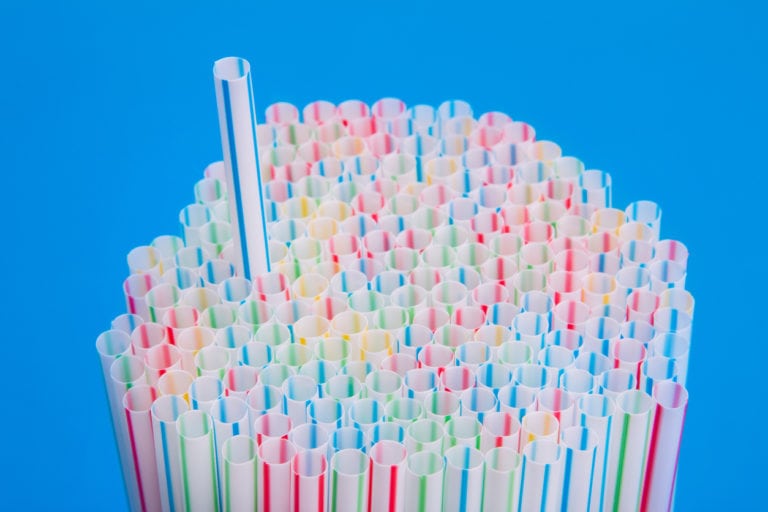Plastic straws have been in the news a lot lately. In an effort to go green, many restaurants, and even entire cities, are making moves to ban them entirely. Earlier this month, the city of Seattle announced plans to do away with plastic straws and utensils. Starbucks announced their plans to ban plastic straws and replace them with paper ones. And most recently, food distributor Aramark has decided to phase out straws in most locations (Aramark serves many college campuses and venues across 19 countries).
There’s a lot to discuss about plastic straws — most of it being negative. And a lot of the information being shared around the internet about plastic straws is true. Straws do take hundreds of years to decompose, and if they end up in the ocean, they can be harmful to marine life. For example, animals easily swallow plastic straws or accidentally get them lodged in their nose or throat. But there are some myths making the rounds, too, and they’re spreading false information about the implications of plastic straw use.
Don’t get us wrong: Plastic pollution IS a real problem in the world, and specifically for the ocean. We’re definitely not denying that. But with plastic straws in the news so much lately, it’s important to separate the myths from the facts. Let’s talk about four myths about plastic straws that we need to set straight.
Myth #1: Americans go through 500 million plastic straws every day.
This is one statistic that gets cited a lot, especially with the new plastic straw bans taking effect. But where did this 500 million figure actually come from? It turns out, it came from a 9-year-old. Libertarian magazine Reason reports that back in 2011, a boy named Milo Cress conducted phone surveys with three straw manufacturers. Based on estimates they gave him, he averaged their answers together and ended up with the 500 million figure.
But once Cress appeared on CNN to report his findings, the statistic spread like wildfire — and continues to be cited to this day by major media outlets like The Washington Post, The Guardian ,and National Geographic. In reality, according to data from Technomic, Americans went through about 170-175 million straws per day in 2017, Reuters reports. It’s still a lot, but it’s not 500 million.
Myth #2: Banning straws will have a huge impact on the environment.
Many believe that banning straws will produce a noticeable change in the environment. But it will probably largely go unnoticed. During an interview with Reason, Angela Logomasini, a Senior Fellow at the Competitive Enterprise Institute, said that banning plastic straws will accomplish “probably nothing at all,” given that so little of the plastic pollution in the ocean actually comes from the U.S. (But on that in a minute.) She continued: “It might make some people in Hollywood feel good, it might make some politicians feel good — like they’re doing something — it might sound good at parties. But it’s not going to solve any problems.”
The larger worry is that people will think that by reducing or eliminating their plastic straw use, they’ll be making a big impact. When really, it’s only a small step in what should be a series of many larger ones. “Banning straws is about as important as spitting in the wind,” psychologist Robert Gifford told Grist. “But a lot of social psychology research says that if you get people to say yes to a small request, they are more likely to accede to more serious requests.”
Myth #3: Plastic straws are the biggest threat to ocean pollution right now.
According to research conducted by Australian scientists Denise Hardesty and Chris Wilcox, there are nearly 8.3 billion plastic straws polluting coastlines around the world, Bloomberg reports. And while that is a serious figure, when you look at the bigger picture, it hardly makes a dent. Those 8.3 billion plastic straws only account for .03% of the 8 million metric tons of plastics dumped into the ocean every year.
What’s the biggest threat? According to a global survey of beach cleanups conducted by the Ocean Conservancy, the top 10 items collected during ocean cleanup are, in order: cigarette butts, plastic beverage bottles, plastic bottle caps, food wrappers, plastic grocery bags, plastic lids, straws and stirrers, glass beverage bottles, other plastic bags, and foam takeaway containers. The survey reports that over 1.8 million cigarette butts were collected, while just over 400,000 straws and stirrers were collected.
Myth #4: Paper and bamboo straws don’t have any negative effects on the environment.
While paper and bamboo straws may be better for the environment than plastic straws, they aren’t without their flaws. “Paper products take more energy and more effort to produce. You’re going to have a net negative environmental impact,” Logomasini continued. “Paper doesn’t degrade in a landfill either. Everything is essentially mummified.”
A lot of reusable straws are made from polylactic acid, a.k.a. “corn plastic.” But John Reeve of Plastico, a U.K.-based plastic tableware company, says many of these straws still end up in landfills. Further, he thinks that biodegradable labels aren’t much more than “guilt-free packaging” designed to make you feel better about your carbon footprint, CNBC reports.
Myth #5: We should just do away with straws altogether because nobody needs them.
With all the talk around straws, both plastic and biodegradable, it might sound like the best solution would be doing away with straws altogether. But not so fast. Some people do require straws. Many disability advocates have spoken out about the straw ban recently.
“Plastic straws are an accessible way for people with certain disabilities to consume food and drinks,” said Katherine Carroll, a policy analyst at the Center for Disability Rights, Time reports. “It seems the blanket bans are not taking into account that they need straws and also that plastic straw replacements are not accessible to people.”
Furthermore, the solution isn’t as easy as members of the disabled community turning to sustainable straws as an alternative. As Vox points out, depending on the nature of one’s disability, metal, paper, glass, or any number of other materials might not be an option. Someone may not have the means to keep a metal straw sterile, may not be able to switch out a paper straw if it weakens or disintegrates, and may be at risk with a fragile material like glass.
So while plastic pollution is an undeniably big problem, plastic straws may not contribute to it as much as you might think. However, we’re still big believers that no action is too small. If you want to reduce your carbon footprint, consider cutting out plastic products and investing in alternatives. Then, consider what sustainable change you could make next.








